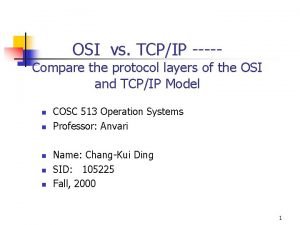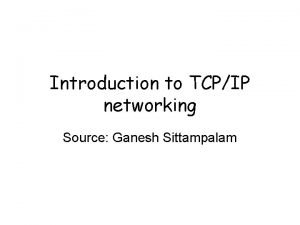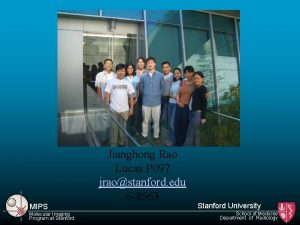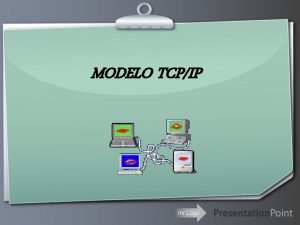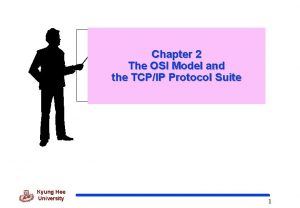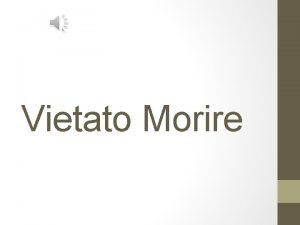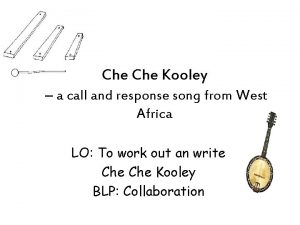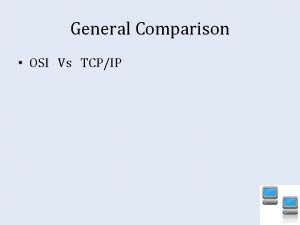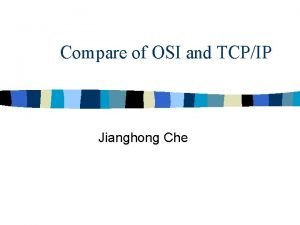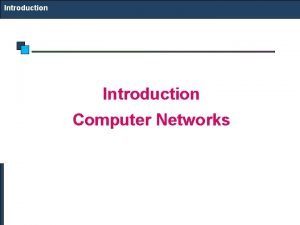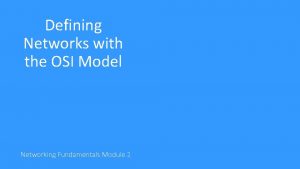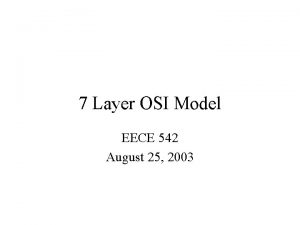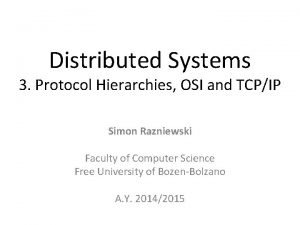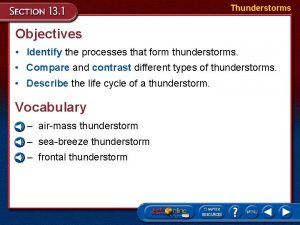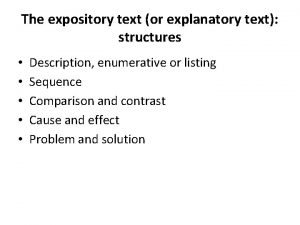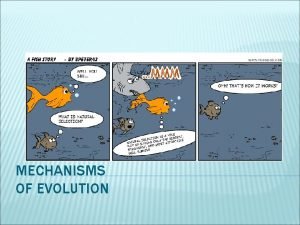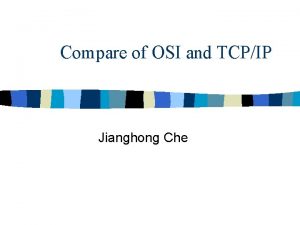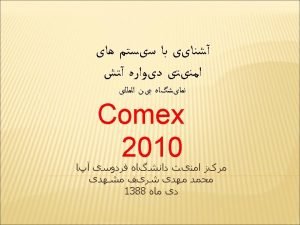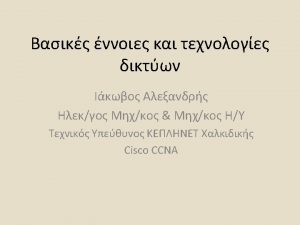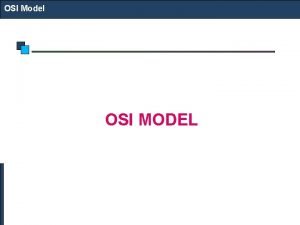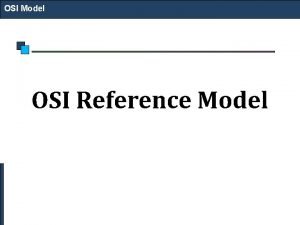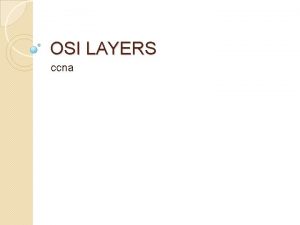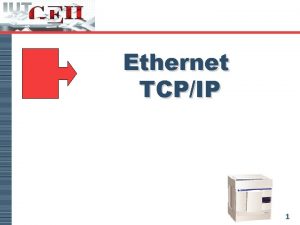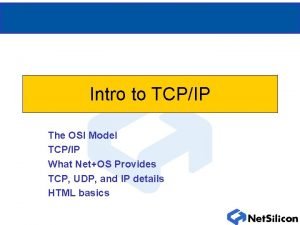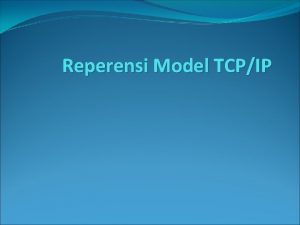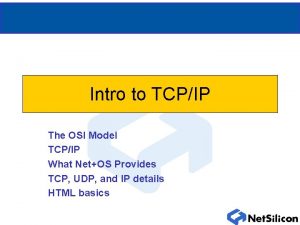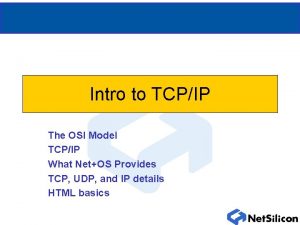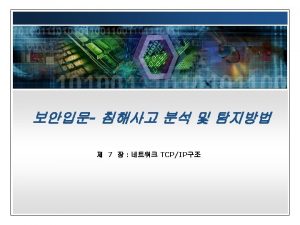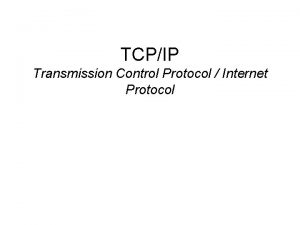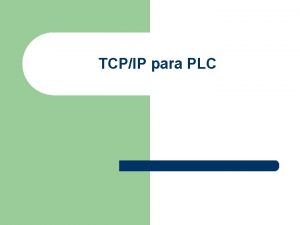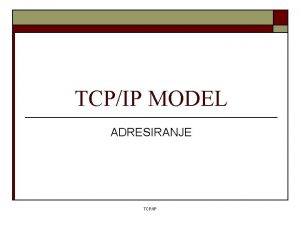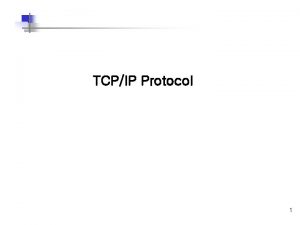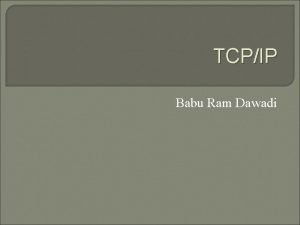Compare of OSI and TCPIP Jianghong Che Contents









































- Slides: 41

Compare of OSI and TCP/IP Jianghong Che

Contents n n n Concept General Compare Lower Layers Compare Upper Layers Compare Critique

Concept n OSI: Open Systems Interconnection. It was developed by ISO as a first step toward international standardization of the protocol used in various layers. It deals with connecting open system. . n TCP/IP: Transport Control Protocol/Internet Protocol. TCP is used in connection with IP and operates at the transport layer. IP is the set of convention used to pass packets from one host to another.

General Compare n n Similarity Difference

Similarity n n Both are based on the concept of a stack of independent protocols. The functionality of the layers is roughly similar.

Difference n n OSI makes the distinction between services, interfaces, and protocol. The OSI model was devised before the protocols were invented. It can be made to work in diverse heterogeneous n n TCP/IP does not originally clearly distinguish between services, interface, and protocol. TCP/IP model was just a description of the existing protocols. The model and the protocol fit perfectly.

Difference (continue) n The OSI model supports both connectionless and connection-oriented communication in the network layer, but only connectionoriented communication in the transport layer. n The TCP/IP model has only one mode in the network layer (connectionless) but supports both modes in the transport layer, giving the user choice.

Difference (continue) n OSI has seven layers Application Presentation Session Transport Network Data link Physical n TCP/IP has four layers Application Transport Internet Host-to-network

Difference (continue) n OSI emphasis on providing a reliable data transfer service, Each layer of the OSI model detects and handles errors, all data transmitted includes checksums. The transport layer checks source- n TCP/IP treats reliability as an end to end Problem. The transport layer handles all error detection and recovery, it was checksums, acknowledgments, and timeouts to control

Difference (continue) n Host on OSI implementations do not handle network operations. n TCP/IP hosts participate in most network protocols.

Lower Layers Compare n n n Data link/Physical vs Subnet Network vs Internet Transport vs TCP/UDP

Data link/Physical vs Subnet n OSI has Data Link/Physical layers. Data link layer dear with error detection and correction. Physical layer refer to the physical connection of network. n The lower layers below the Interface or Network layer of TCP/IP seldom discussed. This protocol has not defined and varies from host to host and network to network.

Network vs Internet – Protocols of the network/internet layer – Ways of addressing – The routing architecture

Protocols of the network layer X. 25 IP n n n A connectionoriented protocol. Virtual circuit approach is used. Logical connection or virtual circuit is established before any packet are sent i. e. Call Setup phase. n n n A connectionless oriented protocol. Data-gram approach is used. Each packet is treated independently.

Protocols of the network layer X. 25 IP n n Each packet contains a virtual circuit identifier as well as data. Node need not make a routing decision. It is made only once for each connection. n Packets of the message do not all follow the same route and may arrive at the destination in a different sequence from the one in which they were sent

Internetworking Protocols OSI TCP/IP n CLNP accommodates variable-length addresses. n IP supports fixed, 32 -bit address.

Compares the functions of CLNP to those of IP

Header formats of CLNP

Header formats of IP

Network Layer Addresses OSI Network Layer Addressing n n The network-layer addressing defines network addressing domains--IDP (AFI, IDI) and DSP. It identifies the abstract service access point between the transport and network layers. n n IP Addresses IP address consists of 32 bits, include networknumber part and hostnumber part. It identifies the actual point of attachment of a computer system to a real sub-network (the “network interface”).

Three different classes of IP address

NSAP address

The routing architecture (OSI) – A set of routing protocols that allow end systems and intermediate systems to collect and distribute the information necessary to determine routes. A routing information base containing this information, from which routes between end systems can be computed A routing algorithm that uses the information contained in the routing information base to derive routes between end systems. – End systems (ESs) and intermediate systems (ISs) use routing protocols to distribute (“advertise”) some or all of the information stored in their locally maintained routing information base.

The routing architecture (OSI Continue) n n The routing information base consists of a table of entries that identify a destination; the sub-network over which packets should be forwarded to reach that destination; and some form of routing metric, which expresses one or more characteristics of the route. The routing algorithm uses the information contained in the routing information base to compute actual routes.

The routing architecture (TCP/IP) n The TCP/IP routing architecture looks very much like the OSI routing architecture. Hosts use a discovery protocol to obtain the identification of gateways and other hosts attached to the same network (sub-network). Gateways within autonomous systems (routing domains) operate an interior gateway protocol (intra-domain IS-IS routing protocol), and between autonomous systems, they operate exterior or border gateway protocols (inter-domain routing protocols).

Transport vs TCP/ UDP n n n OSI Transport layer TCP/UDP Compare of Transport and TCP/IP


TCP/UDP TCP n n n Provide reliable data transmission. Responsible for data recovery. Allows the receiver to specify the amount of data it wants sent to it. (Important status information is sent by TCP connection). UDP n It’s fast but does not provide reliable data transmission. (main data stream sent by UDP).


TCP/UDP (continue) n n TCP, UDP both communicate using the concept ports (FTP, TELNET, SMTP, HTTP, POP 3). By specifying ports and including port numbers with TCP/UDP data, the process of multiplexing is achieved. The port numbers, along with the source and destination addresses for the data, determine a socket. Socket make the


Compare of the Two Model n Most of the TCP and UDP functions and specifications map to the OSI Transport Layer. n The TCP/IP and OSI architecture models both employ all connection and connectionless models at transport layer.

Compare of the Two Model OSI TCP/IP n n uses the terms connection-mode and connection-oriented for the connection model and the term connectionless-mode for the connectionless model. its network layer controls the operation of a sub-net, provides routing, congestion control and accounting. n simply “connections” and data-grams.

Upper layers Compare n n n Session Presentation Application

Session Layer OSI TCP/IP n n The Session layer handles session setup, data or message exchanges, and tear down when the session ends. It also monitors session identification so only designated parties can participate and security services to control access to session information. n n The TCP/IP model does not have a general session layer protocol. In TCP/IP the term “sockets” and “ports” are used to describe the path over which cooperating application communicates.

Presentation Layer OSI TCP/IP n The Presentation Layer handles data format information for networked communications. For outgoing messages, it converts data into a generic format that can survive the rigors of network transmission; for incoming messages, it converts data from its generic networked n Presentation layer is not present in TCP/IP model. Instead this function is frequently handled within the applications in TCP/IP through External Data Representation Standard(XDR) and

Application Layer n Application provides a set of interfaces for applications to obtain access to networked services such as networked file transfer, message handling, and database query processing.

Application Layer (Continue) – An end-user interface that provides a human or another application with: – The means to enter commands that direct the application to send files to and receive file from a remote host, list or change directories, rename or delete file, etc. – The means of performing input to and output from mass storage device(s) (disk-tape). – The means of transferring the files and file-related information between hosts.

Approach OSI TCP/IP n n Application entities in OSI may have many. End-user applications developed using common applicationdevelopment infrastructure. n n Application entities in TCP/IP have a single service element. Each application was developed independently, from “top” to “bottom”.

OSI n n Critique TCP/IP Bad timing, by the time the OSI protocols appeared, the competition TCP/IP protocols were already in widespread use. Bad technology, both the model and the protocols are flawed, the model along with the associated service definitions and protocols are very complex. n n The model does not clearly distinguish the concepts of services, interface, and protocol. It is not at all general and is poorly suited to describing any protocol stack other than TCP/IP.

Critique (continue) OSI TCP/IP n n Bad implementation, the initial implementations were huge, unwieldy, and slow. (poor quality) Bad politics, it was thought to be the creature of the government. n n The host-to-network layer is not really a layer. The model does not distinguished the physical and data link layers
 Osi vs tcp
Osi vs tcp Osi tcpip
Osi tcpip Jianghong rao
Jianghong rao History of the osi model
History of the osi model Tcpip
Tcpip Modelo tcpip
Modelo tcpip Protocolo tcpip
Protocolo tcpip Tcp/ip logo
Tcp/ip logo Tcpip model
Tcpip model Frasi con una subordinata soggettiva
Frasi con una subordinata soggettiva La vita che avrai non sarà mai distante dall'amore che dai
La vita che avrai non sarà mai distante dall'amore che dai Che che kooley
Che che kooley Facesti come quei che va di notte che porta il lume
Facesti come quei che va di notte che porta il lume Osi vs tcp ip
Osi vs tcp ip Comparison and critique of osi and tcp/ip model
Comparison and critique of osi and tcp/ip model Compare and contrast west side story and romeo and juliet
Compare and contrast west side story and romeo and juliet Cause and effect contents of the dead man's pocket
Cause and effect contents of the dead man's pocket Visceral parietal pericardium
Visceral parietal pericardium Outlining and organizing the speech contents
Outlining and organizing the speech contents Elagse
Elagse Goals of computer network
Goals of computer network Which layer in the osi model covers http, ftp, and rdc?
Which layer in the osi model covers http, ftp, and rdc? Encapsulation and decapsulation in osi model
Encapsulation and decapsulation in osi model Osi reference model
Osi reference model What did the sibley commission do
What did the sibley commission do Compression and rarefaction
Compression and rarefaction Compare and contrast spring tides and neap tides.
Compare and contrast spring tides and neap tides. Compare and contrast cold wave and wind chill factor
Compare and contrast cold wave and wind chill factor Narrative vs expository text
Narrative vs expository text Compare and contrast analog and digital forecasts.
Compare and contrast analog and digital forecasts. Venn diagram of typhoon and tornado
Venn diagram of typhoon and tornado The most dangerous game summary
The most dangerous game summary Compare and contrast transverse and longitudinal waves
Compare and contrast transverse and longitudinal waves Physical change
Physical change Compare and contrast gradualism and punctuated equilibrium
Compare and contrast gradualism and punctuated equilibrium Compare and contrast macbeth and lady macbeth
Compare and contrast macbeth and lady macbeth Compare and contrast macbeth
Compare and contrast macbeth Lady macbeth soliloquy
Lady macbeth soliloquy This country is known for its unique vocals
This country is known for its unique vocals Truman vs eisenhower
Truman vs eisenhower Draco malfoy traits
Draco malfoy traits Compare and contrast community and ecosystem
Compare and contrast community and ecosystem
